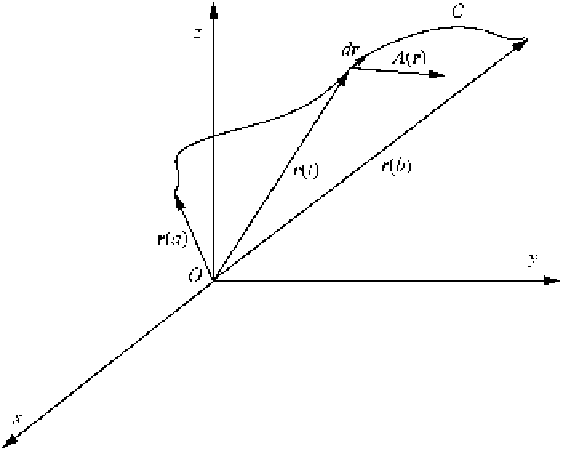Geology Reference
In-Depth Information
Fig. A1.6
Geometrical
relationships in the
calculation of line integrals
Given a vector field
A
D
A
(
r
), a
line integral
over the path
C
is a scalar quantity given by:
Clearly, by (
A1.13
) closed loop line integrals
of potential fields are always zero, so that
I
results
to be independent from the path linking
r
(
a
)to
r
(
b
). For this reason potential fields are said to
be
conservative
. Just as a curve in the three-
dimensional space, a
surface S
in
<
Z
I
D
A .r/
dr
(A1.12)
C
3
can be
defined in parametric form. In this instance, two
parameters,
u
and
v
, must be defined in a region
D
of
<
Figure
A1.6
illustrates the general approach
followed in the computation of line integrals,
such as the work associated with a force field. We
simply substitute the parametric equation (
A1.11
)
into (
A1.12
), which reduces the integral to a
standard definite integral. To this purpose, it is
necessary determining a parametric expression
for the infinitesimal displacement vector
d
r
.This
is accomplished differentiating (
A1.11
). When
A
coincides with the gradient of a scalar field, we
say that
A
is a
potential field
. In this instance, the
following analogue of the fundamental theorem
of calculus holds:
2
. These parameters are used to identify
position vectors on
S
.
Then, likewise paths, parametric surfaces are
defined by equations of the form:
r
D
r .
u
;
v
/
D
x.
u
;
v
/i
C
y.
u
;
v
/j
C
z
.
u
;
v
/k
I
2
.
u
;
v
/
2
D
R
(A1.15)
At any point on
S
, the normal versor
n
can be
used to define a vector representing the oriented
surface element
d
S
D
n
dS
, which has magnitude
equal to the infinitesimal area
dS
and normal
versor
n
. Given a vector field
A
D
A
(
r
), the
flux
through the surface
S
is defined as the integral:
Z
I
D
r
¥
dr
D
¥.r.b//
¥.r.a//
C
(A1.13)
Z
ˆ
D
A .r/
dS
(A1.16)
When the two end points of a path coincide, so
that
C
forms a
closed loop
, we write:
S
I
Once again, the integral is calculated
substituting the parametric equations (
A1.15
)
into (
A1.16
). The following
Stokes' theorem
is a
I
D
A .r/
dr
(A1.14)
C

